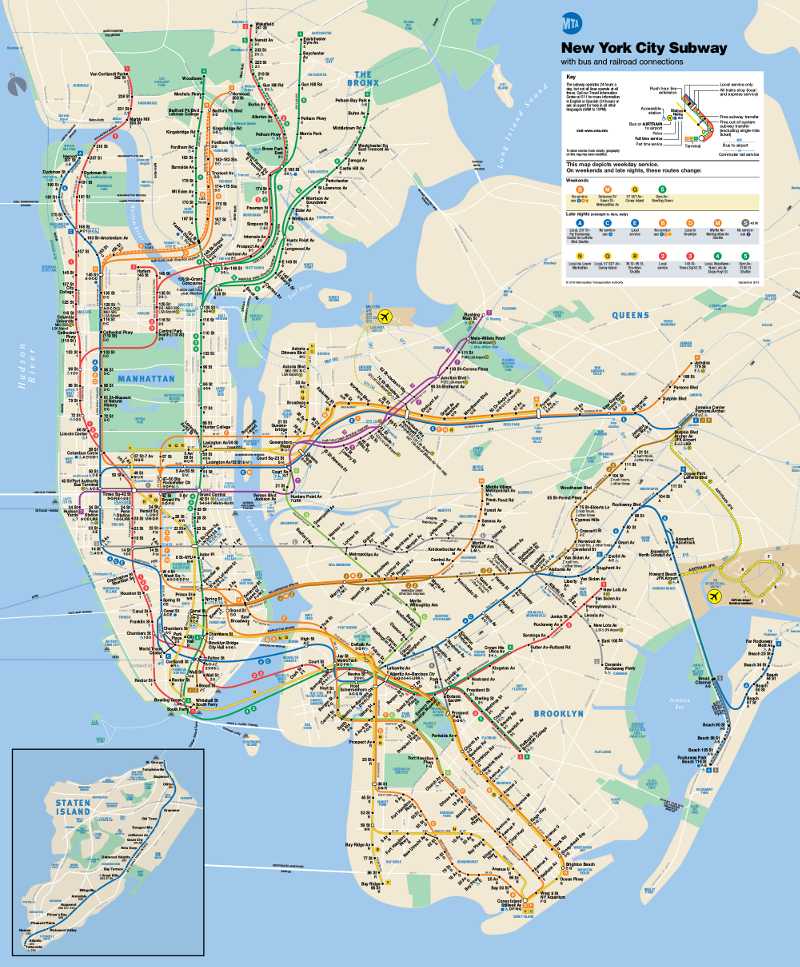The New York City Subway is the metro system in New York City, New York. The underground trains of the metro were inaugurated in October 27, 1904. Some of its stations work 24/7, while others work until evening. The metro connects to the John F. Kennedy International Airport via AirTrain, which go from the terminals to the Jamaica and Howard Beach stations. This metro has 472 stations, divided into four boroughs: Queens, The Bronx, Manhattan, and Brooklyn. There are plans to expand some of its stations between 2027 and 2029. You can arrive within one hour from the airport to places such as Times Square or the Statue of Liberty. The metro rides can be paid with the MetroCard card.
Metros in the United States: New York City Subway
New York City has a strong influence with its art, entertainment, technology, and business. It is the leading city in creativity and financial power in the world. The city is divided into five boroughs: Staten Island, Manhattan, Queens, The Bronx, and Brooklyn. It boasts from having the most number of languages spoken within a city in the world. New York City has a population of approximately 8 million people.
The city is famous for places such as Times Square and Broadway Theater. It holds three of the most visited places by tourists in the world. The United Nations offices are located here. Its metro, the New York City Subway, has some stations that work 24 hours a day, all week long.
History
New York City Subway is one of the oldest, busiest, largest and more complex rapid transit rail system in the United States and in the whole world. The harsh winter conditions in the late 19th century in New York City made people consider underground transportation as an easier means of travel. The New York City Subway's underground lines construction was planned in 1894, and began in 1900. On October 27, 1904, its first underground line was opened, the Interborough Rapid Transit Subway (IRT) 9th Avenue Line. Some years before, a section above ground level was built, inaugurated in July 3, 1868. The metro used to be privately owned by two companies, until the city's government bought it in 1940. It was managed by the New York City Transit Authority from 1953 until 1968, when the state took control of the metro and began managing it via the Metropolitan Transportation Authority (MTA.)
How to ride the New York City: Quick Video Guide
Bonus tip: The New York Pass
Safe time and money. All the info HERE!.
Lines and stations
The metro has 472 stations. The lines and stations are divided into four boroughs: Manhattan, Queens, The Bronx, and Brooklyn. The lines in each borough are the following:
Manhattan
This borough has 151 stations. Its lines are the following: Second Avenue Line, Sixth Avenue Line, Eight Avenue Line, 42nd Street Line, 63rd Street Line, Broadway Line, Broadway-7th Avenue Line, Canarsie Line, Concourse Line, Flushing Line, Lenox Avenue Line, Lexington Avenue Line, Nassau Street Line, Queens Boulevard Line (53rd Street Crosstown)
Queens
This borough has 81 stations. Its lines are: 63rd Street Line, Archer Avenue Lines, Astoria Line, Crosstown Line, Flushing Line, Fulton Street Line, Jamaica Line, Myrtle Avenue Line, Queens Boulevard Line, Rockaway Line
The Bronx
This borough has 70 stations. Its lines are: Broadway-7th Avenue Line, Concourse Line, Dyre Avenue Line, Jerome Avenue Line, Pelham Line, White Plains Road Line
Brooklyn
This borough has 170 stations. Its lines are: Fourth Avenue Line, Sixth Avenue Line, Eighth Avenue Line, Brighton Line, Broadway-7th Avenue Line, Canarsie Line, Crosstown Line, Culver Line, Eastern Parkway Line, Franklin Avenue Line, Fulton Street Line, Jamaica Line, Myrtle Avenue Line, New Lots Line, Nostrand Avenue Line, Sea Beach Line, West End Line.
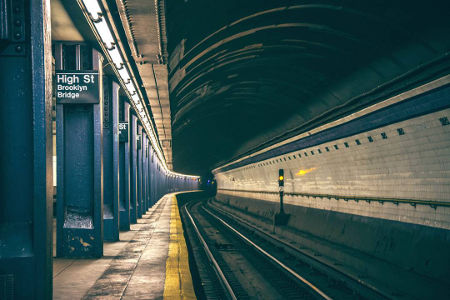 Brooklyn Bridge
Brooklyn Bridge
Because of its complexity and dynamism, Ney York City subway has its own nomenclature. Routes change because connections and services are created, opened or modified, because the time of the day and because of the system maintenance. In New York City Subway a line is a track or group of tracks. We can consider lines as the physical component of the system. Lines are designated by a name. Routes are the logical and dynamic compoment of the system and are built on top of the lines. Routes use lines to link terminals in the system. A route (also known as a service) is named by a letter or a number. Each route has a colour and a local or express designation. There are 24 train services in the subway system.
- Exclusively local trains:: 1, 6, 7, C, G, L, M and R.
- Local and express trains: 2, 3, 4, 5, 6, 7, A, B, D, E, F, N and Q.
- Special trains The J train has a local services but in rush hours works with Z train in the peak direction.
- Shuttle service: S trains: Franklin Avenue Shuttle, Rockaway Park Shuttle, and 42nd Street Shuttle.
New York City Subway consists of 2 divisions, A Division (IRT) and B Division (BMT/IND).
A Division:
- Route 1 (red): Broadway – Seventh Avenue Local: Van Cortlandt Park-242 St (Bronx) to South Ferry Station (Manhattan)
- Route 2 (red): Broadway – Seventh Avenue Express: Wakefield (Bronx) to Brooklyn College-Flatbush Av (Brooklyn)
- Route 3 (red): Broadway – Seventh Avenue Express: Harlem-48 St (Manhattan) to Van Siclen Av (Brooklyn)
- Route 4 (green): Lexington Avenue Express: Woodlawn (Bronx) to Crown Hts-Utica Av (Brooklyn)
- Route 5 (green): Lexington Avenue Express: Eastchester-Dyre Av (Bronx) to Bowling Green (Manhattan)
- Route 6 and NYCS Route 6d (green): Lexington Avenue Local (Pelham Local/Express): Pelham Bay Park (Bronx) to Brooklyn Bridge-City Hall (Manhattan)
- Route 7 and Route 7d (purple): Flushing Local/Express: Times Sq-42 St (Manhattan) to Flushing Main St
- Route S (grey): 42nd Street Shuttle: Grand Central to Times Sq-42 St (Manhattan)
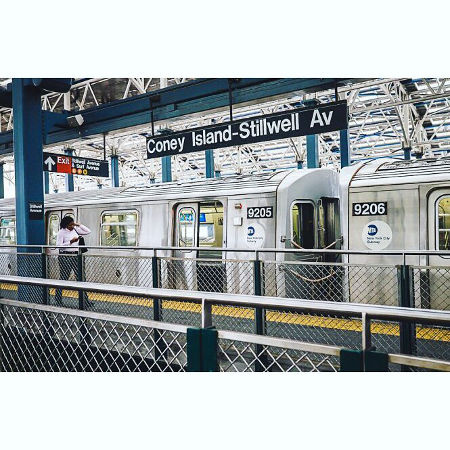 MTA Subway, Coney Island
MTA Subway, Coney Island
- Route A (blue): Eighth Avenue Express: Inwood-207 St (Manhattan) to Ozone Park-Lefferts Blvd or Far Rockaway-Mott Av (Queens)
- Route B (orange): Sixth Avenue Express: [Beford Park Blvd. ( Bronx)] - 145 St (Manhattan) to Coney Island Stillwell Av (Brooklyn)
- Route C (blue): Eighth Avenue Local: Washington Hts-168 St (Manhattan) to Euclid Av (Brooklyn)
- Route D (orange): Sixth Avenue Express: Norwood-205 St ( Bronx) to Coney Island Stillwell Av (Brooklyn)
- Route E (blue): Eighth Avenue Local: Jamaica Center-Parsons/Archer (Queens) to World Trade Center (Manhattan)
- Route F (orange): Sixth Avenue Local: Jamaica-179 St (Queens) to Coney Island-Stillwell Av (Brooklyn) via 63 St Connector and Jay St-Borough Hall (Brooklyn)
- Route G (light green): Court Sq (Queens) to Smith-9 Sts (Brooklyn)
- Route J (brown): Nassau Street Local: Jamaica Center-Parsons/Archer (Queens) to Chambers St (Manhattan) or Broad St (Manhattan)
- Route L (grey): 14 St (Manhattan) to Canarsie-Rockaway Pkwy (Brooklyn)
- Route M (orange): Sixth Avenue Local: Middle Village-Metropolitan Av (Queens) to Chambers St (Manhattan)
- Route N (yellow): Broadway Local: Astoria-Ditmars Blvd (Queens) to Coney Island-Stillwell Av (Brooklyn) via Pacific St (Brooklyn)
- Route Q (yellow): Broadway Express: 57 Street/7th Avenue (Manhattan) to Coney Island-Stillwell Av (Brooklyn)
- Route R (yellow): Broadway Local: Forest Hills-71 Av (Queens) to Bay Ridge-95 St (Brooklyn) via Pacific St (Brooklyn)
- Route S (grey): Franklin Avenue Shuttle: Franklin Av to Prospect Park (Brooklyn)
- Route S (grey): Rockaway Park Shuttle: Broad Channel to Rockaway Park-Beach 116 St (Queens)
- Route Z (brown): Nassau Street Express: Jamaica Center-Parsons/Archer (Queens) to Broad St (Manhattan)
- Route V: Forest Hills-71 Av (Queens) to Lower East Side
- Route W: Astoria-Ditmars Blvd (Queens) to Whitehall St (Manhattan)
Rail connections
The transportation agencies in which the New York City Subway makes connections are: PATH, AirTrain JFK, Amtrack, Metro-North Railroad, Long Island Rail Road, and New Jersey Transit. Connections are also available to ferry services such as New York Waterway, Staten Island Ferry, and New York Water Taxi. Connections to bus services are available for George Washington Bridge Bus Terminal, and Port Authority Bus Terminal.
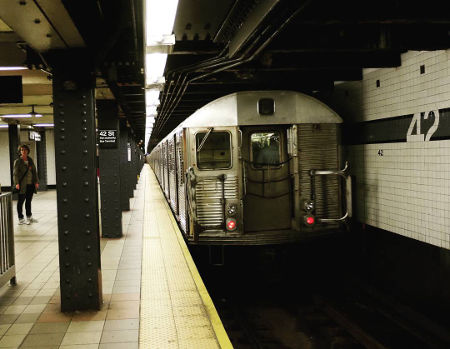 MTA Subway
MTA Subway
Connection to the airport
The international airport in New York City is John F. Kennedy International Airport, located in the Queens borough. Most of the points of interest in New York City are located in Manhattan. To get quickly from the airport to Manhattan, ride on AirTrain, which is available in all of the airport's terminals. Then, make a transfer to the New York City Subway in either the Jamaica Station or the Howard Beach station.
Schedule, timetables, and hour of operations
The New York City Subway has multiple schedule for over 24 routes. The weekday schedules for some of its routes are the following:
- 1) Route 1: There is a train available every five minutes. Service begins on Van Cortlandt Park-242 Street station in The Bronx at 00:07 am, and ends in South Ferry station in Manhattan at 00:51 am on the following day.
- 2) Route 2: A train is available every 10 minutes. The metro service begins in Wakefield-241 Street station in The Bronx at 00:01 am, and ends in Flatbush Avenue station in Brooklyn at 1:09 am on the following day.
- 3) Route 3: A train is available every 7 minutes. The metro service begins in Harlem-148 Street, 7th Avenue station in Manhattan at 00:03 am, and ends in New Lots Avenue station in Brooklyn, at 00:10 am on the following day.
- 4) Route 4: A train is available every 7 minutes. The metro service begins in Woodlawn station in The Bronx at 00:06 am, and ends in New Lots Avenue station in Brooklyn at 1:13 am on the following day.
- 5) Route 5: A train is available every 8 minutes. The metro service begins on Eastchester-Dire Avenue station in The Bronx at 5:13 am, and ends in Flatbush Avenue station in Brooklyn at 8:54 pm.
- 6) Route 6: A train is available every 6 minutes. The metro service begins on Pelhalm Bay Park station in The Bronx in 00:07 am, and ends Brooklyn Bridge station in Manhattan at 1:13 pm.
- 7) Route 7: A train is available every four minutes. The metro service begins on Flushing-Main Street station in Queens at 00:12 am, and ends in 34 Street-Hudson Yards station in Manhattan at 00:35 am the following day.
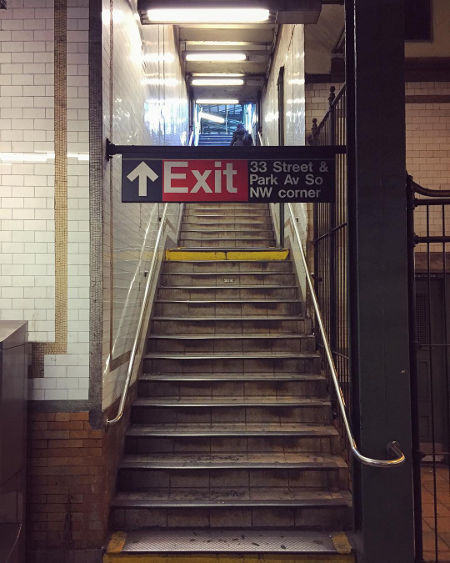 Park Avenue
Park Avenue
Frecuency
There is a train every 2-3 in rush hours and every 10-15 rest of the time.
Price, tickets, and cards
A ticket for using the metro or a regular bus costs $2.75. An express bus ticket costs $6.50. You can get a 50% discount if you are a senior citizen of 65 years and older, or if you are a disabled citizen. If an adult pays for a ticket, they can bring three children below 45 inches tall for free. Additionally, if an adult pays for a ticket for an express bus, they can bring children who are two years old or under for free, as long as the children sit down on the bus.
The main way of paying the rides in New York City Subway is with a card called the MetroCard. If you use the MetroCard, you could save money. There are different services for different types of MetroCard:
- a) Pay-per-Ride MetroCard: You can purchase your desired number of trips on the metro. They are sold at metro stations and in vending machines. Its prices range between $5.50 and $80, and you receive 11% extra money in your card for extra rides. It offers free transfers from the metro to buses.
- b) Unlimited Ride MetroCard: This card has a fixed price, and offers infinite bus and metro rides. You can choose among different services for this card: 7-Day, 30-Day, and 7-Day Express Bus Plus. AirTrain, PATH, and express buses do not accept 7-Day nor 30-Day Unlimited Ride cards. AirTrain accepts JFK AirTrain MetroCard and JFK AirTrain 10-Trip MetroCard.
- b.1) 7-Day Unlimited Pass ($31) ($15.50 for seniors/disabled): Infinite subway and bus rides for one week until midnight. This card is not accepted by AirTrain, PATH, nor express buses.
- b.2) 30-Day Unlimited Ride MetroCard ($116.50) ($58.25 for seniors/disabled): This card lets you use the metro indefinitely for 30 days until midnight. This card is not accepted by AirTrain, PATH, nor express buses. If purchased with debit card or credit card at a vending machine, you have anti-theft protection for your purchase.
- b.3) 7-Day Express Bus Plus MetroCard ($57.25) (No discounts offered): This card lets you use the metro, regular buses, and express buses indefinitely for 7 days until midnight. If bought at a vending machine with a debit or credit card, you have anti-theft protection for your purchase.
- b.4) JFK-AirTrain 30-Day Unlimited Ride MetroCard ($40): This card gives you rides for 30 days until midnight for trains in JFK-AirTrain.
- b.5) JFK-AirTrain 10-Trip MetroCard ($25): This card offers you 10 rides in JFK-AirTrain. This card expires in six months. It is sold at shops, the airport, and at AirTrain vending machines.
-
Note: Each new MetroCard bought costs $1.
- c) Easy Pay MetroCard: This card is linked to your debit or credit card to refill the MetroCard once you run out of rides. It takes three weeks to get it through the mail. This card is a convenient way of paying to refill your MetroCard. You can keep track of the balance left via a phone call. This MetroCard has an expiration date, but you will receive a renewed card one week before the old one expires. To get this card, you need to go to the online MetroCard site, and select whether you want the Pay-per-Ride or the Unlimited Ride MetroCard. For seniors and disabled citizens, they can fill out a physical form and mail it, and they get discounts.
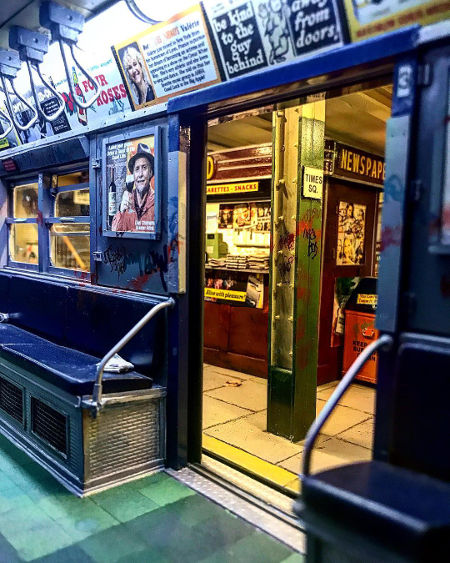 Time Square Station
Time Square Station
MetroCards can be bought at vending machines, booths at stations, buses, shops, or even from your employer if you live on New York City.
How to use the MetroCard in the metro:
Swipe the card on the card machine with the name on the card facing you. Enter the metro if you see "Go" on the screen. If the screen shows the message "Swipe again," you cannot pass, but you were not charged. If the screen displays "Swipe card at this machine," you will be charged if you swipe your card at another turnstile. If the screen displays "Seek for help," contact the metro's staff, since there is a problem with your card.
How to check your MetroCard's balance:
1) At a booth reader: Look for a booth in the station. Swipe your card in the booth's reader, and the screen will display your balance left, your time left, and the expiration date on the card.
2) At a MetroCard machine: There are special machines specifically made to read the MetroCard's balance, which will be displayed once you insert the card in the machine.
3) At a turnstile: When you swipe your card on the machine to board the metro, the screen will display your available balance.
How to use MetroCard on the bus:
When you get inside a bus, insert your card with the black line facing you, and the card will pop-up once your fare is deducted from it. The screen will show the following information:
- 1) If you used a Pay-per-Ride card, the screen will show the amount paid.
- 2) If you used a time-based card, the screen will show the date of expiration.
Places where you can use the MetroCard:
1) Pay-per-Ride MetroCard: Valid in regular buses, express buses, and the MTA New York City Transit metro. It is also valid in the following transportation agencies: NICE Bus (Nassau Inter-County Express), MTA Staten Island Railway, Roosevelt Island Tram, All Path Stations, MTA Bus Company, Westchester Bee Line Buses, JFK-AirTrain.
2) Unlimited Ride MetroCard: Valid on regular buses, and MTA New York City Transit metro. The card is also valid in: NICE Bus (Nassau Inter-County Express), MTA Staten Island Railway, Roosevelt Island Tram, MTA Bus Company, Westchester Bee Line Buses.
3) 7-Day Express Bus Plus: Only works on New York City private express buses, MTA buses, and New York City Transit express buses.
Rules in NYC Subway
- Making noise of over 85 dB is not allowed.
- Open containers with liquids in it are not allowed either.
- You need to give your seat to a disabled person if requested by them.
- Smoking inside the metro is prohibited.
- If you are sleeping, do not disturb other passengers. You can use radios or other multimedia devices only if you use them with headphones or earphones.
- Do not drink alcohol, and do not possess alcohol with an open container, unless the metro is near a bar or restaurant.
- Taking pictures and/or recording video is permitted, as long as you do not use tripods.
- Animals are not allowed, unless they are in cages or they have the purpose of helping the disabled.
Future expansions:
The line with the most number of planned expansions is the Second Avenue Subway in Manhattan. Among the expansions planned in the Second Avenue Subway are:
- East Harlem: 116th Street and 106th Street stations in between 2027 and 2029.
- East Harlem/Harlem: 125th Street station in between 2027 and 2029.
- Turtle Bay: 42nd Street station.
- East Midtown: 55th Street station.
- Kips Bay: 23rd Street station.
- Murray Hill: 34th Street station.
- East Village: Houston Street and 14th Street stations.
- Financial District: Seaport and Hanover Square stations.
- Chinatown: Grand Street and Chatham Square stations.
 New York Metro
New York Metro
Tips in NY City Subway
Rush hours occur between 7 am and 10 am, and between 5 pm and 8 pm. Avoid riding the metro on those times to avoid crowded trains.
There are two types of trains: Local and Express. The Local trains stop in every station, making it a slower choice of travel. Express trains skips many stations, making it faster than Local trains. If you are new using the metro, use Local trains. If you are an experienced metro traveler, and you have a map of the Express train stops, use the Express trains.
Download a map on your smartphone and bookmark New York City Subway's website (http://www.mta.info) to plan your trip. The distances are long and there are many stations, so you could get lost if you do not plan your route.
You can use one MetroCard for many people, so you can share it with friends and family. However, the Unlimited Rides card takes 20 minutes to work between uses, while Pay-per-Ride cards can be used many times without waiting. Plan ahead if you want to invite family and/or friends to buy a Pay-per-Ride card.
Fun facts
There are round-shaped lamps in front of the stations, colored in either green or red. If the lamps are green, the station is open 24 hours. If the lamps are red, the station closes at night.
This metro is the most crowded metro in the United States, with over 1.5 billion passengers per year. As high as that number may seem, New York City subway is the seventh busiest system in the world. Asian cities subways are even busiest: Tokyo, Seoul, Moscow, Beijing, Shanghai, and Guangzhou haver a higher annual ridership.
The price of the metro's ticket is linked to the price of a slice of pizza in New York City's restaurants. When the price of pizza goes up, the ticket's price goes up too.
The metro's turnstiles started accepting tokens in 1953 and were eventually replaced by the MetroCard. However, you could still use tokens in the early 2000s, even though MetroCards were widely available.
If the metro is delayed and causes you to arrive late to work, the metro's managers will give you a letter to your employer to excuse your late arrival.
Grand Central Terminal, is the world's largest railway station by number of platforms.
Although it is known as "Subway" about forty percent circulaes by surface or elevated routes.
Art is present everywhere in the subway. There are permanent installations, artistic decoration and musicians.
During the 70s, muggings and graffiti were a common problem in the metro, but the issues were fixed in the 90s.
Some of the metro's stations have been reconstructed after they had been destroyed by the attacks of September 11 and Hurricane Sandy.
The metro's construction was difficult since it involved digging on the streets to make the tunnel and then rebuild the street. This caused traffic problems. Nowadays, the tunnels are made with a digging machine that works underground, without the need of destroying streets.
The metro has had multiple expansions, like the opening of the IND Sixth Avenue Line in 1940, and the 7 Subway Extension Line in 2015.
Nearby attractions
Follow these instructions to go to these touristic attractions from John F. Kennedy's International Airport-Terminal 1 using the metro:
- 1) Central Park: The trip lasts one hour and 10 minutes. From the airport, take a train towards the JFK AirTrain-Jamaica Station (ticket costs $5). Then, from Sutphin Boulevard-Archer AV/JFK E/J/Z/LIRR station, take the World Trade Center train towards the 7th AV station B/D/E (ticket costs $2.75). Then, transfer to the Bedford Park Boulevard train towards 103rd Street B/C. Central Park is a beautiful park with green areas that contrasts with concrete of the surrounding city.
- 2) Statue of Liberty: The trip lasts 1 hour and 15 minutes. Take a train towards JFK AirTrain-Howard Beach Station. Then, take the 207th Street-Inwood train towards Fulton Street A/C station. From here, you need to walk half a mile southwest to the Statue of Liberty. This is the world's tallest statue, with plenty of guided tours offered to go to the top of it.
- 3) Broadway: The trip lasts one hour. Take a train towards JFK AirTrain-Jamaica Station (the ticket costs $5). Then, from Sutphin Boulevard-Archer AV/JFK E/J/Z/LIRR, take the World Trade Center train towards 7th AV Station B/D/E (ticket costs $2.75). There are many theaters in Broadway’s Streets, with famous and classic plays from top-notch actors.
- 4) Empire State Building: The trip lasts one hour and 10 minutes. From the JFK AirTrain-Terminal 1 Station, take a train towards JFK AirTrain-Jamaica Station (ticket costs $5). Then, from Sutphin Boulevard-Archer AV/JFK E/J/Z/LIRR station, take the World Trade Center train towards 34th Street-Penn Station C/E (the ticket costs $2.75). Walk half a mile southeast to the Empire State. This is one of the most famous landmarks in New York City. It attracts a lot of tourists to go to the top of the building, where you can observe New York City and other surrounding cities.
- 5) Fifth Avenue: The trip lasts one hour. From the JFK AirTrain-Terminal 1 Station, take a train towards the JFK AirTrain-Jamaica station (the ticket costs 5$). Then, from the Sutphin Boulevard-Archer AV/JFK E/J/Z/LIRR station, take the World Trade Center train towards the Union TNPK-Kew Gardens E/F/LIRR station (the ticket costs $2.75). Then, transfer to the Stillwell AV-Coney Island train towards the 42nd Street-Bryant Park B/D/F/M station. This is the best place to do shopping in New York. It has the biggest shops from known brands, such as the Apple Store or Cartier on Fifth Avenue.
- 6) Metropolitan Museum of Art: The trip lasts one hour and 20 minutes. From the JFK AirTrain-Terminal 1 station, take a train towards the JFK AirTrain-Jamaica Station (the ticket costs $5). Then, from Sutphin Boulevard-Archer AV/JFK E/J/Z/LIRR station, take the World Trade Center Train towards the Lexington Avenue-53rd Street E/M station (the ticket costs $2.75). Follow the signs to 51st Street Station 6. Transfer to the Pelhalm Bay Park-Express train towards 77th Street Station 6. Walk half a mile northwest. This is a museum with over one million art pieces, which are mostly from American history.
- 7) Times Square: The trip lasts one hour. From the JFK AirTrain-Terminal 1 station, take a train towards the JFK AirTrain-Jamaica Station (the ticket costs $5). Then, from the Sutphin Boulevard-Archer AV/JFK E/J/Z/LIRR station, take the World Trade Center train towards the 42nd Street-Port Authority Bus Terminal A/C/E station (the ticket costs $2.75). Walk 0.1 miles east. This is the home of The New York Times newspaper. It has big billboards, and it is a good location to watch plays and do shopping.
- 8) Rockefeller Center: The trip lasts one hour. Take a train from the JFK AirTrain-Terminal 1 station towards the JFK AirTrain-Jamaica station (the ticket costs $5). Then, from the Sutphin Boulevard-Archer AV/JFK E/J/Z/LIRR station, take the World Trade Center train towards Fifth Avenue-53rd Street E/M station (the ticket costs $2.75). Walk 0.2 miles southwest. This is the location of NBC-TV. This place also offers a beautiful view of the city from the Rock Observation Deck.
Metro map of New York City
Map via web.mta.infoSee map full resolution. It may take a little bit to load.
New York City Subway map
- Also Known As: Subway
- Passengers/Day 5080000
- Fares: 1.53
- 24h operation: Every night: 20 subway lines, SIR, PATH
- Air Conditioning: Yes
- Walk between platforms: No
- Driverless trains: No
- Screen Doors Platforms: Planned for new Second Avenue Line
- Operator: New York City Transit Authority (NYCTA)
- $2
- New York City Metro Official Website
Help us
If you consider that the information we provide is wrong, not accurated, outdated, translation contains errors, and you would like to help us to improve the file...you can contact us here.
Feel free to contact us if you dont find the system you're looking for and we'll add it as soon as we can!
Thank you very much!







